














Dear Fellow Bronx Science Alumni,
It’s been another exhilarating fall at Bronx Science. It was a delight to witness how the Bronx Science community simply burst with collective pride when the news broke that Hall of Famer Dr. Claudia Goldin ’63 was awarded a Nobel Prize in Economics—and became our school’s NINTH Nobel Laureate! The number of alumni who sent me a note to congratulate Dr. Goldin, stopped me on the street, or called to share their excitement was simply overwhelming. How lucky we are to be a part of such a close knit community who roots for one another’s success.
Our students today evoke the greatness of our alumni. It is special to walk the halls of Bronx Science, get to know the student body and wonder: how will each of these extraordinary students one day make their mark on the world?
Please enjoy the updates and stories shared here in our Winter 2024 Alumni Magazine. We have a terrific spring planned with a lot of wonderful opportunities for Bronx Science alumni to get together, and we hope to see you all there. Please keep in touch in the meantime!
Best,
 Eleanor Coufos ’99 President Bronx Science Foundation
Eleanor Coufos ’99 President Bronx Science Foundation

The 2023–2024 school year is off to an incredible start at the Bronx Science Foundation. Our bright and ambitious students continue to inspire and impress us—as do our alumni like you!
This fall, we shared that a Bronx Science alumnus offered to match all gifts dollarfor-dollar, up to $500,000. The response from this community was incredible, and we are thrilled to share that, in typical Bronx Science fashion, we blew away that $500,000 goal!
We have raised more than $1.3 million to date this school year, thanks to the generous support of so many alumni, parents and friends. Foundation gifts make a real impact on Bronx Science students each and every day.

Here’s just a sampling of what the Foundation accomplished in the Fall 2023 semester, thanks to the support of alumni and friends:
Launched a free arts initiative to make New York City’s vibrant cultural scene accessible to students by coordinating trips to see The Nutcracker, & Juliet, The Magic Flute and more;
Hosted a series of college support programs, including our new College Liaison program, College Supplement Review, and Project Accepted, which gave more than 400 seniors the opportunity to practice interviews with alumni volunteers;
Opened the first full academic year of student research in the Stanley Manne ’52 Research Institute (and please see below for new hiring opportunities in the Manne Institute!);
Held an Alumni in Law Networking Reception, the first in a series of industryspecific networking events planned for this year; and
Provided dozens of students with financial aid to make it possible to attend extracurricular trips like Speech & Debate tournaments—and to ensure that such experiences are equal opportunity at Bronx Science, regardless of individual means.
In short, the alumni community’s generosity ensures that today’s talented and hardworking Bronx Science students have access to the resources and opportunities they deserve. We are so grateful for this community’s commitment to our school, and we look forward to continuing our work together this spring to maintain our legacy of excellence.

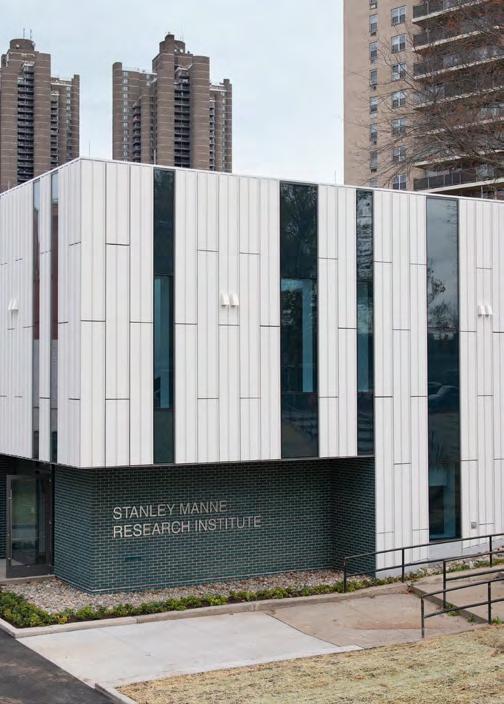
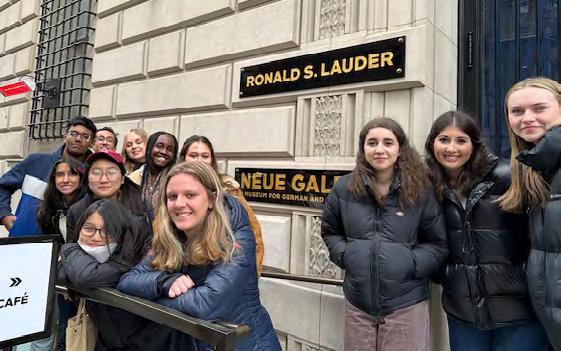

THE MANNE INSTITUTE IS HIRING
Please circulate to your friends and family—this is a unique opportunity to be a part of this transformative facility!
FULL-TIME:
Science Research Training and Education Fellow
PART-TIME: Research Fellow
Interested applicants should email foundation@bxscience.edu.
The Wolverines are off to another action-packed season this 2023–2024 school year! In addition to the Girls Varsity Swimming making the playoffs and both the Boys and Girls Cross-Country teams winning borough championships, improvements for the athletics program as a whole may make this 2023–2024 year the most successful yet. Athletic Director Michael McGrath debuted a new software and advanced camera to livestream games and meets. The videos, all available on the Bronx Science website under “Athletic News,” allow students, families and recruiters to view select highlights or the entire game.

This year the Bronx Science gymnastics team is back and better than ever, growing in numbers and spirit following the return of Ms. Vasso Konstatakakos. 'Ms. K', as she's referred to by students, is in her tenth season coaching. From 10 members in the 2021–2022 season to over 20 this year, the growth in numbers gave the team a needed morale boost.
Lisa Nikitina ’25, a returning team member said, “practice never feels empty, and it feels like a more cohesive team.”
“In recent years we got some new equipment, new bars, and some new floor equipment,” McGrath added. “We invested in that and it’s nice to see that it’s being used.”
With more members, the team attracts a wide range of athletes.
“Everyone brings their energy. I have a lot of returning athletes from two years ago who are bringing back what the team was and introducing it to the new athletes who are going to continue this legacy,” Ms. K reflected.
“Part of the reason we are really strong this year is, with more people, we have a unique set of skills,” says team captain Elise Boyson ’24, referring to team members who are experienced in Tae-Kwon-do or rhythmic gymnastics.
“The personality is what makes it fun. No one is the same. Most of us have the same buns and leotards but you get to see each of us through the sport.” Nikitina added


Ms. K said, “I want my gymnasts to find love and joy in the sport, and to be excited to come to practice. Come, learn, enjoy, socialize.”
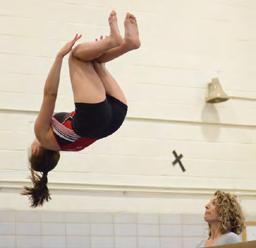

Boys Varsity Basketball has long been one of Bronx Science’s most popular teams. In one of the hardest divisions of the city, they have managed to win 11 of 15 games so far this season, including against our long-standing rival, Stuyvesant. Yet, the division is tough and the team faced recent losses, upon which team captain Andrew Kibel ’24 reflected. “That losing streak was a little setback and we weren’t ready for those games,” but referring to a recent win against Roosevelt
Campus, “we kind of got our momentum back.”
Coach Robert Massimi is also confident in the team this season. “The team plays with grit and determination,” he said. “They are smart players, they can anticipate plays and passes, and have high basketball IQs.”
Alpha Keita ’24 is just one of the star players that have led the team this season, consistently one of the top point scorers. He also tops charts city-wide, currently at #1 in rebounds in the city with 146 and #4 in points in the Bronx with 181. Keita attributes his success this year to his hard work training in the off-season and shifting mindset. “As a player my confidence has gone up and this year I think I see things differently. I look at it as trying to be the best as I can at every aspect of the game.”
“Alpha is a super special player. He has matured and grown so much over the last year,” Coach Massimi said. Keita has gained attention from college coaches and scouts, with several contacting Coach Massimi and the Bronx Science team regarding his future prospects.
Looking ahead, all Keita said was, “my plan is to take it as far as I can go.”
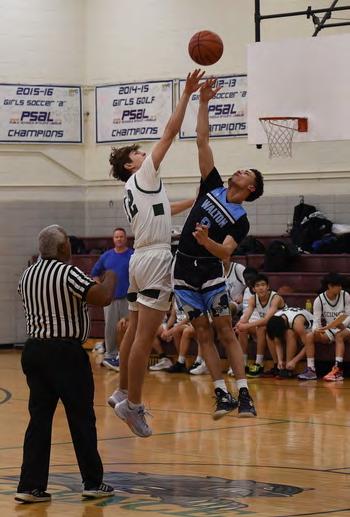
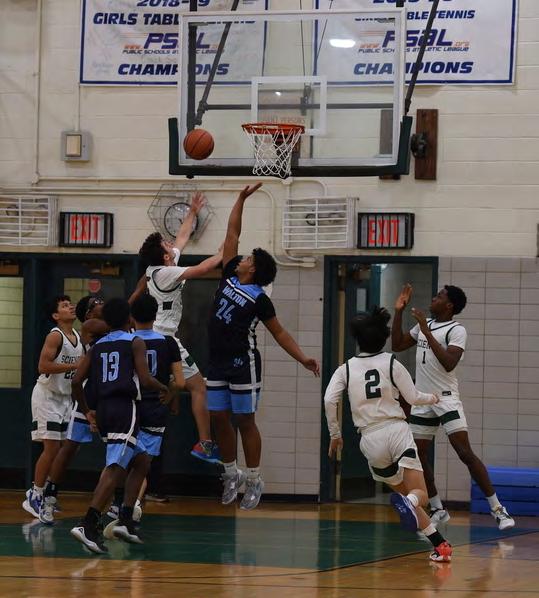

Kurt Vonnegut once called science “magic that works.” Considering the implications of the work Bronx Science research students have undertaken, science truly has taken on a magical lens, turning hundreds of hours of dedicated study into an almost limitless future in medicine, media, and more.
Many notable students demonstrated this power through participation in the Regeneron Science Talent Search, now simply called “Regeneron” for short. Awarding $1.8 million dollars to 300 students across 36 states and China, the Science Talent Search serves as
the oldest and most distinguished science and math competition for high school seniors, of which Regeneron is the sponsor. (Depending on when alumni graduated, you may remember Westinghouse or Intel as the sponsor).
The competition highlights studies with worldwide impact, whether through models working towards a cure of celiac disease to robots and satellites to government analysis. Past honorees have since received Nobel Prizes, National Medals of Science, and similarly prestigious awards.
Out of more than 2,000 applicants across 712 schools, the competition names 300 total scholars.
Bronx Science was recognized with nine "scholars”—the term for semi-finalists—and the second highest number of recognized students of any school featured. They have been recognized for their impressive research, innovation, leadership, academic rigor, and community engagement.

Let’s celebrate this year’s Regeneron Science Talent Search scholars, all class of 2024: Sophie D'Halleweyn, Aiden Hightower, Melody Jiang, Nema Khan, Ryan Kim, Jonathan Lin, Dimitrios Mahairas, Kun-Hyung Roh, and Rachel Wu.
D'Halleweyn and Roh were also named finalists, now competing for further awards in a weeklong extensive judging process with a guarantee of at least $25,000 each. Bronx Science is one of three schools nationwide with the honor of having more than one finalist, a truly prestigious recognition.

In fact, the founder of the company Regeneron, George Yancopoulos ’76, is a Bronx Science alumnus who serves as the financial sponsor of the competition. Dr. Yancopoulos participated in the Westinghouse Science Talent Search as a student at Bronx Science (and was named a finalist), so he was inspired to sponsor the competition, believing it played a pivotal role in giving him his start in science. The commitment to research and scientific improvement clearly expands long after graduation.
Since the inception of the program over 80 years ago, Bronx Science students have followed a three year path of intensive research projects, culminating in Regeneron submission. They collaborate with professors, researchers and doctors—often more than double their ages—to produce tangible and meaningful studies whose impact spans far beyond the classroom.
Entering research at Bronx Science is a lengthy and rigorous endeavor, beginning with the Science Research course and outstanding grades in ninth grade, to qualify for this individualized program. There are four sections: social sciences, mathematics and computer science, physical science/engineering, and biology. Students pick a track to begin in sophomore year, continue developing their projects as juniors, and then submit final papers in senior year.
The past four years have not reflected the typical process, however. Dr. Tracy LaGrassa, biology research teacher, shared, “Most students in this group of seniors experienced their first year of high school remotely, during the height of the
pandemic. They did not have the benefit of 9th grade research—the foundational course of the research program—and it was really hard to get a lab after sophomore year, because of COVID restrictions on lab personnel. Yet, they still managed to make all this progress. They came to school in 10th grade and formed real friendships and got deeply involved in the school culture, research as only one part. They helped their communities. They had tremendous responsibilities at home. How they did all this, I cannot imagine. I am beyond proud of them.”
Sophie D’Halleweyn ’24 — Alleviating the Energy Crisis: A Novel Multi-Task Machine Learning Algorithm for Designing Efficient Nanocatalysts To Reduce Industrial Energy Impact
Aiden Hightower ’24 — Molecular Fusion: A New Methodology for the Rational Design of Novel DNA Motifs via the DX-Mediated Binding of DNA Tensegrity Triangle Unit Blocks
Melody Jiang ’24 — Characterizing Effects of Natural Killer Cell Neural Cell Adhesion Molecule 1 Interactions With Stromal Cells on Natural Killer Cell Development
Nema Khan ’24 — The Impact of Media Attention to Gun Violence on the Elevation of Mass Shootings: The Rise of Copycat Shooters
Ryan Kim ’24 — Exploring the Pathways of c-Maf Endothelial Cell Reprogramming
The scholars have adapted over the course of their studies, developing skills from the typical data analysis to the less technical but still crucial successful subway navigation, and built projects that will radically change the future of science. Their age is an inspiration, equipping them to approach research with new ideas and creative problem-solving. All intend to continue immersing themselves in scientific study after graduation, and one can only imagine excitedly what next steps they will take.
Jonathan Lin ’24 — Analysis of Distinctive MicroRNA Conservation Patterns as Markers for Unique MicoRNA Processing Mechanisms
Dimitrios Mahairas ’24 — Overcoming Dataset Imbalance Using Light-Weight Vision Transformers With Applications to Computational Drug Design Derived From Botanical Prototypes During PostAntibiotic Era
Kun-Hyung Roh ’24 — Novel Drug Discovery Methodology Using Machine Learning for Gene Expression-Based Virtual Screening Predicts Novel Compounds To Reverse Alzheimer’s Disease With Applications to Cancer and Longevity by Inhibiting CtBP2 Expression
Rachel Wu ’24 — Detecting the Effect of Textual Features in Social Media Using an Innovative Machine Learning Approach With Applications for Managing Public Opinion
This fall, Bronx Science Hall of Famer Claudia Goldin ’63 was awarded the Nobel Prize in Economics for having “advanced our understanding of women’s labor market outcomes.” Goldin was the third woman to receive this prize and the first to do so solo. Throughout an impressive career spanning more than four decades, Goldin has published groundbreaking studies that revealed key insights on the female labor force, paving the way for women in the field of economics.
Goldin grew up in the Bronx and attended Bronx Science from 1959 to 1963. Like most Bronx Science students, her commute was tedious—she transferred between three different public buses, one way—but worth it. “It took a lot of effort to get there, but I never once thought that it was a difficult thing to do,” Goldin said. “I loved it. I loved every part of it.”
There were no girls’ sports teams at the time, so Goldin found other ways to be involved in the school community. When she wasn’t studying or hanging out with friends, she spent her time fulfilling her responsibilities as a member of the Student Council, Library Squad, Attendance Squad, and ARISTA. “And, I knit a lot of sweaters,” she added with a laugh.
The summer of Goldin’s junior year, she participated in an NSF Advanced Placement Program at Cornell University. There, she was introduced to microbiology, sparking an interest in life sciences. After graduating high school, Goldin returned to Cornell for college with the original intention of continuing to explore microbiology. However, she soon realized that her passion lay elsewhere.
Goldin was first exposed to economics when she took a class taught by Alfred Kahn, a “dedicated and exciting” professor who later became the head of the U.S. Civil Aeronautics Board. His enthusiasm for regulation was contagious; Goldin quickly dove into the field of industrial organization and wrote her undergraduate thesis on the regulation of satellites.

Goldin next attended the University of Chicago for graduate school, where she expanded her focus to labor economics and economic history. Her PhD dissertation—which became her first book, “Urban Slavery in the American South”—examined the antebellum economy in southern cities. Building off of this research, Goldin and esteemed colleague Frank Lewis later published the widely cited paper “The Economic Cost of the American Civil War” in 1975.
“It took a while for me to realize that what I wanted to do was write a definitive book on the history of women in the labor force,” Goldin said, even though this topic is what she is arguably most known for today. She has, in fact, now written two: “Understanding the Gender Gap” in 1990 and “Career & Family” in 2021.
Piecing together the past, Goldin tracked the history of the female labor force and identified five major phases of how they have historically prioritized family, jobs, and careers.


“By joining the labor force, by increasing labor force participation, [women] were interesting,” said Goldin, explaining what drew her to study this so thoroughly. “It’s not interesting if a group doesn’t change anything.”
The gender wage gap during the earlier phases was largely due to discrimination, differences in education, and occupational segregation. Yet although a disparity still exists today—American women earn 83 cents to a man’s dollar—the same factors from previous generations only account for a third of the difference. The root cause, Goldin discovered, is women’s struggle to balance career and family, along with the distinction between ‘greedy’ and ‘flexible’ work.
If a man and a woman with identical educational backgrounds entered the same profession—for example, law—their salaries would initially be similar. Goldin’s research proves that it is only once the woman starts to have children that the gap widens considerably. At this stage of life, the average mother makes less than 60 cents to a man’s dollar, while other women would experience little change. The gap shrinks again as mothers enter their fifties and sixties.
In this example, the man and woman are both lawyers, an occupation that Goldin would define as ‘greedy.’ Greedy work demands a lot of time and disproportionately pays more for longer hours. Another example is a surgeon, who may need to be on call to perform an emergency operation with little notice. A pediatrician, on the
other hand, has a lower salary but more flexibility because they can reschedule appointments as needed. Flexible work allows for additional freedom and appeals to many phase five women who shoulder familial responsibilities on top of their career.
The gender wage gap is, more accurately, a parental gender wage gap. Women’s traditional role as caretakers has been ingrained in American culture since long before any of Goldin’s five phases. Therefore, more mothers choose lowerpaying flexible work than fathers, and their subsequent smaller average income is known as the ‘Motherhood Penalty.’ The driving force behind the gender wage gap, Goldin concluded, is couple inequity.
Through decades of research and studies, Goldin traced women’s fluctuating involvement in the labor force and explored the evolving tension between career and family that underlies the gender wage gap. By studying the women of the past, Goldin has inspired countless young women of today and left a lasting impression in the historically male-dominated field of economics.
In 1990, Goldin became the first tenured female professor in the Harvard economics department, where she continues to
teach today. She was the president of the Economic History Association from 1990 to 2000 and the president of the renowned American Economic Association from 2013 to 2014. A year later, Goldin initiated the Undergraduate Women in Economics Challenge, encouraging more young women to major in economics.
Goldin has also earned numerous awards, including three Richard A. Lester Awards for the Outstanding Book in Industrial Relations and Labor Economics—and, of course, her recent Nobel Prize.
When she found out about the Nobel, Goldin said, it was 4:30 am. She got out of bed, started making breakfast, told her husband to take the dog out, and prepared to meet the press later—all in all, not an entirely unordinary morning.
But something monumental was happening, reaching far beyond the walls of Goldin’s home.
“What was announced at six in the morning on October 9th was an award that was magnified thousands of times, millions of times,” Goldin reflected.
Goldin has made impressive strides since her days at Bronx Science. Perhaps her biggest accomplishment, however, is the far-reaching impact she has had on so many around the world—from fellow acclaimed economists and aspiring economic researchers, to the women whose work and inherent value is now better appreciated and recognized.
“I realized by the middle of the day that I had received an enormous amount of mail and calls from people who weren’t simply saying that they were congratulating me,” Goldin continued.
“They were saying that they themselves felt validated and vindicated, that they themselves felt emboldened and proud.”

“ It was not just my [Nobel], it was other people’s as well. It was for women, it was for those working on the areas of gender, it was particularly for women in countries in which women’s employment is restricted in various ways.”
The Bronx High School of Science is known for its unparalleled contribution to the world's sharpest minds. Since its creation in 1938, Bronx Science has had nine brilliant people be awarded a Nobel Prize for their research in the fields of chemistry,
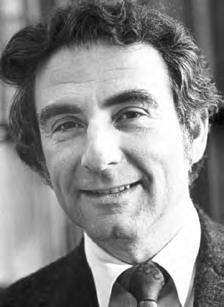

physics, and—most recently—economics. Bronx Science holds a high school record of Nobel Prizes, and more locally far exceeds Stuyvesant with four laureates and the Brooklyn Technical High School with two.
The first Bronx Science alumnus to win a Nobel Prize did so in 1972, a mere 34 years after the school had first opened. Dr. Leon Cooper received the Nobel Prize for his extensive research in the field of physics. After graduating from Bronx Science, Dr. Cooper attended Columbia University where he received a Bachelor’s, Master’s, and Ph.D. After ending his long journey at Columbia, Dr. Cooper began his research at Brown University where he dedicated himself to developing the BCM theory of superconductivity, for which he won the Nobel Prize.
After graduating Bronx Science in 1950, Dr. Sheldon Glashow earned his Bachelor's at Cornell University, and his Ph.D. at Harvard University. Dr. Glashow won the Nobel Prize in 1979 for his research which formed the basis of the accepted theory of the electroweak interactions. Dr. Glashow describes his lasting contribution to the field as the creation of a standard model. He reflects, “You read your textbooks and learn about quarks, electroweak interactions, quantum chromodynamics, all of which are subjects I contributed to. I feel very proud to have played a visible role in the world of physics.”
Bronx Science is pleased to welcome Hall of Famer Dr. Claudia Goldin ’63 into its elite group of Nobel Prize laureates reinforcing the school's longstanding tradition of excellence. Dr. Goldin’s academic achievements in the field of economics, characterized by her research in the gender wage-gap, acts as a beacon of inspiration to the young and curious minds that Bronx Science continues to foster and inspire.
Dr. Goldin’s fellow graduate and Nobel Prize laureate Dr. Sheldon Glashow ’50 details in an interview over a phone call,
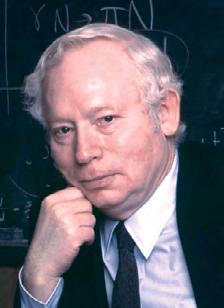

“I am so delighted to have Dr. Goldin join our club, I hope there will be many more of us and I hope she and I will have the pleasure to welcome the 10th, 11th, and even 12th members of our club!” But with all the hope for the future generations of Bronx Science it is important to recall and honor the accomplishments who continue to make Bronx Science a place filled with curiosity and innovation. With that, below is a brief description of the eight past Nobel Prize laureates and their contributions to the fields of physics and chemistry.
Dr. Steven Weinberg was a theoretical physicist who won the Nobel Prize in 1979 alongside his friend, classmate, and research partner, Dr. Glashow. After graduating from Bronx Science, Dr. Weinberg received his Bachelor’s from Cornell University and his Ph.D from Princeton University where he researched elementary particles and physical cosmology.
Upon graduation, Dr. Melvin Schwartz went on to study at Columbia University for both his Bachelor’s and Ph.D. After earning his Ph.D, Schwartz immediately was made an assistant professor at Columbia University in 1958. After 17 years at Columbia University, Dr. Schwartz moved to Stanford University in 1966 to begin researching the charge asymmetry in the decay of long-lived neutral kaons. He later specialized in classical electrodynamics which led him to discover the neutrino beam method, winning him the Nobel Prize in 1988.

Dr. Russell Hulse was awarded the 1993 Nobel Prize in Physics for his contribution to the field of astrophysics. After graduating from Bronx Science in 1966, Hulse received his Bachelor’s from The Cooper Union and his Ph.D from the University of Massachusetts, Amherst. In 1974, Hulse and his team discovered a pulsar, a compact star that emits radio waves with a regular variation made up of two stars rotating around each other. Hulse now serves as the Associate Vice President for Research at the University of Texas, Dallas.

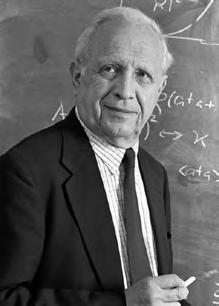
Dr. David Politzer was awarded the Nobel Prize in 2004 for his contributions to the field of physics for his work with the strong interaction, the interaction that holds together the protons and neutrons that comprise the atomic nucleus. After graduating from Bronx Science in 1966, Politzer earned his Bachelor’s from the University of Michigan and his Ph.D from Harvard University. Dr. Polizer is now a professor of theoretical physics at the California Institute of Technology.
After graduating from Bronx Science in 1941, Dr. Roy Glauber began his studies at Harvard. There he was recruited to work on the Manhattan Project where he focused on calculating the critical mass for the atom bomb. He later returned to Harvard where he completed his degree as well as his Ph.D where he researched quantum optics. This, combined with his theory on high-energy collision theory, won him the Nobel Prize in 2005.

Dr. Lefkowitz was awarded the Nobel Prize in 2012 for his study of cellular receptors in the hormone adrenaline and the discovery of “G-protein-coupled receptors”, used in more than half of medications today. Dr. Lefkowitz is the 8th Nobel Prize laureate from Bronx Science but the first in Chemistry. After graduating from Bronx Science, Dr. Lefkowitz received his Bachelor’s and Master’s from Columbia University and is now a professor of Medicine at Duke University. In an interview Dr. Lefkowitz concluded by offering his congratulations to Dr. Goldin as well reflecting on his lasting contributions to the field of medicine:
“ I think my contribution to the field of medicine was substantial in its time but I have loved seeing it evolve and grow as it continues to be used as the basis for modern day medical research. It is something I am very proud of.”
—Dr. Robert Lefkowitz ̓59
The Bronx Science Foundation aims “to preserve the mission and excellence of The Bronx High School of Science.”
The newest Board member, Regina Bronson ’90, is motivated by that same mission and excited to give back to the Bronx Science community by assisting the current generation of students to achieve their career goals. Bronson shares many experiences with those of current Bronx Science students. Born into an immigrant family and coming from Moldova, she found that a school like Bronx Science, which she called a place with “inherent diversity”, was an incredible turning point in her life. She found that
the resources and opportunities that were available to her were of the utmost importance, and hopes to extend these opportunities to current students.
Furthermore, Bronson aspires to help the Foundation reconnect with Bronx Science’s alumni to gain funding and connect current students with alumni across diverse fields and skill sets.
Bronson considers the Speech & Debate team, founded more than 50 years ago by Richard B. Sodikow ’55, to be her “defining experience at Bronx Science.” During her time on the team, she was chiefly fond of the teamwork, effort, and community displayed amongst her peers, saying “that’s definitely what has stuck with me all these years later.”

Not only did the memories of the Speech & Debate team stick with her, but being a part of this team helped further her career. Although Bronson currently works in finance, it wasn’t the path she intended to take. When she was at Bronx Science, mainly due to her participation in Speech & Debate, she had her sights set on becoming an attorney. Bronson continued to college
with this mindset, attended law school, and worked her summers at law firms. Her first summer working at a law firm, Bronson discovered that “the isolated work as a litigator” wasn’t her cup of tea. The following summer she experimented with M&A (mergers and acquisitions), hoping the fast-paced environment might be more up her alley and realizing the financial aspects of her work were more enticing to her than the legal ones. She began her financial career with investment banking and over time transitioned to her current position as a private wealth advisor, which she does at Goldman Sachs. Although her plan to become a lawyer didn’t go as she had anticipated, she still believes that law school pointed her in the right direction to become successful in the financial industry. Additionally, she believes that the communication skills she learned on the Speech & Debate team helped further her career. It’s why she’s very driven to “continue to see the Speech & Debate team thrive and have the funding that it needs,” she added. Being a part of the Speech & Debate team also allowed Bronson to connect with the Bronx Science community post-graduation. “My primary way for staying in touch is participating in the events that are targeted toward the Speech & Debate team network, we’ve had a bunch of those, and it’s been a really great way to stay in touch with people both in my class and other classes.” Reconnecting with former classmates and meeting other Bronx Science students at these events helped Bronson realize that she wanted to be more involved at her alma mater.
“ It’s been a really great full circle, in the way that it was not something that I would have predicted, but the pull back to the school has been pretty strong as I get older and realize how it set me on such a great path. The Speech & Debate team was such a great part of that.

There is no debate that the goals of most Bronx Science students include beakers, data models, and late nights of studying. However, behind a less obvious curtain, lies the school’s theater department, where students create art and stories that fill both the performers and audience with a sense of school pride and delight.
While the idea of overlap between the arts and a STEM-focused school may seem contradictory, Bronx Science has proven to foster the dreams of students that are now Broadway stars. Such dreams include those of Daniel Yearwood ’13, known for his Broadway roles of John Laurens and Philip in Hamilton for several years and currently playing Anthony in Sweeney Todd.
During his freshman year, Yearwood’s artistic expression was mainly limited to being a drummer in the school’s jazz band. It wasn’t until his sophomore year that he watched the school’s rendition of West Side Story and became utterly entranced by theater.
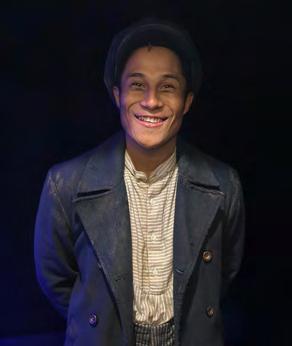
with the Star-Spangled Banner because I really had no idea what to sing,” said Yearwood with a laugh. “I didn’t have a book, or a selection of songs. It was crazy.” Despite his lack of repertoire, Yearwood’s innate inclination secured him the lead in the play. In his later high school years, he gained strong experience in performing arts with the help of Colleen Hawkes-Pierce, the director of the musicals at the time and the first to identify Yearwood’s exceptional talent. “She saw that there was a fervor for the arts,” Yearwood recalled. “I remember her saying, ‘You're good at this. Let's see what else there is.’”

The following year he auditioned for Thoroughly Modern Millie. “I tried out
The friendly competition present amongst his peers seemed to prepare him for the repetitive process of university applications and auditions. Yearwood reflected on his Bronx Science experience, “Was it sought after? Absolutely. But was it the most fun I ever had as a part of a larger group of young people who just had fun dancing? Also yes.”
Yearwood earned his BFA in musical theater at Pace University, where he was a part of 13 productions. “I was very narrow-
minded in the sense of this being what I’m dedicating my life to,” said Yearwood. Upon graduating, he threw himself into the competitive acting scene of New York City and quickly rose to success, obtaining several Broadway leads in just a decade.

To Yearwood, performing and theater is all about continuous growth. From his early years in theater, he simply wanted to gain as much information as he could. “I just kept to myself a good portion of the time and tried to lead with love, grace, and kindness,” Yearwood recalled. “I was a sponge, just taking in as many things as possible.”
Ten years later, one of the major themes fueling Yearwood’s continued success is his hope to use what he has learned to be a roadmap for future Black artists hoping to make it to the “Mecca” that is Broadway. “I didn’t necessarily have anyone who had set a precedent, who I knew personally, especially trying to make it as a Black man in musical theater.”
To Yearwood, it is not the amount of roles one has that defines success as a performer; it is about the community that is formed and the ability to pass on knowledge and experience to those around you. Yearwood emphasizes the impact that his mentors, from his first musical director at Bronx Science to some of the most renowned Broadway actors, have had on how he perceives his role as an actor.
“They've taught me innumerable lessons on how to create longevity not just based on the ‘success’ of my career, but to make sure there's a posterity of the health of my spirit and heart.” To Yearwood, the most exciting thing about being a Broadway actor is being able to not only meet people he has looked up to but to collaborate with them. Even on stage, Yearwood has taught himself to form a connection and community with the audience and his fellow actors, attributing this as a main facet of his success. He sees the lasting impact he leaves to be one of spiritual nature, emphasizing the power of the body, mind, and spirit to leave people feeling moved or to maybe see the world a bit differently. “If it touches you, that is an amazing thing. And if it doesn’t, that is okay,” said Yearwood. “But what is important is that we—the audience and actors—are all gathered together for an hour or two and go on a journey, a shared experience, together.”
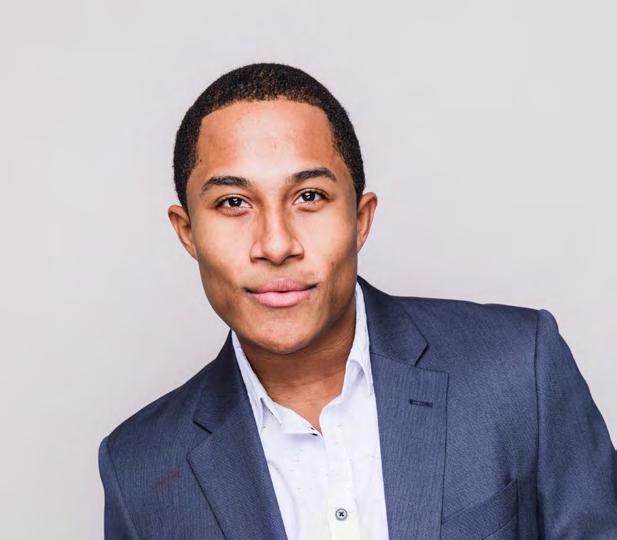
At Alumni Day this year, Nathan Sambul ’64 will be awarded the Alumni Medal of Honor in recognition of his professional achievements and philanthropic endeavors as an alumnus.
Sambul's journey at Bronx Science began in 1960, a period he fondly recalls as formative and influential. As one of the pioneers in the school's shift to include freshmen, Sambul reflected on the pivotal nature of this change. "I arrived as part of one of the first freshman classes, marking a significant transition from parochial to public schooling,” Sambul recalls. Within the walls of Bronx Science, Sambul found himself in an oasis of intellectual rigor and inspiration. The school's environment was not just academically challenging; it was a melting pot of burgeoning talent and innovative teaching. Given the caliber of his peers, Sambul's ambition and intellectual curiosity were ignited. “It was a challenging four-year period, with peers destined for Nobel Prizes and teachers who guided me effectively,” he recounts.
Beyond the high-quality education, he sees his years at Bronx Science as a nurturing ground for the values and principles that would guide him throughout his life. The
school's emphasis on critical thinking, problem-solving, and a culture of excellence deeply influenced his life, contributing significantly to his professional ethos. The school's focus on effective communication and critical thinking was particularly influential in shaping his career in marketing and mass communications.
Sambul is a published author and distinguished figure in the field of strategic marketing and communication, renowned for his expertise in market strategy, research, advertising, public relations, and consumer behavior. His professional journey is marked by significant leadership roles, particularly as the head of marketing for several prominent organizations such as Marsh, a subsidiary of Marsh & McLennan, Merrill Lynch's U.S. Private Client Group, and Crum & Forster, a property and casualty insurance carrier. Sambul holds a Doctor of Business Administration degree from the International School of Management in Paris. His dissertation focused on successful female entrepreneurs who obtained seed funding, demonstrating his commitment to diversity and
entrepreneurial studies. He is significantly involved in the entrepreneurial ecosystem, mentoring and investing in startups, with deep experience in the boardrooms of large enterprises.
The Alumni Medal of Honor presented to Sambul is not just an accolade but a symbol of his lifelong relationship with Bronx Science. “The honor was both unexpected and deeply appreciated,” he admits, and noted that the achievements and philanthropy being acknowledged were truly inspired by the values and education he received at Bronx Science.
Sambul's vision for the school is not just about reminiscing; it's a strategic roadmap for elevating the school to new heights of academic and societal impact.
Drawing inspiration from the Pulitzer Prize, he envisions the establishment of a distinguished award at Bronx Science. "This initiative would bring Bronx Science further into the national spotlight, fostering a culture of excellence and recognition.”
Sambul articulates.
Sambul is working with the Bronx Science Foundation on how the prize will be structured, and he is excited about the
possibilities it holds. For Bronx Science, this would mean an elevation of its already prestigious status, potentially attracting top-tier educators, driving curriculum innovation, and fostering an environment that continually challenges its students.
As Sambul continues to support and inspire Bronx Science, his story stands as an emblematic example of the profound impact one individual can have in shaping the future of an institution and, by extension, the future leaders it nurtures.

For decades Bronx Science has helped shape its students. The school instills a great sense of self-determination, courage and perseverance, as seen with one particular alumna: Dr. Myriam Sarachik ’50. Among her many talents, Sarachik was a renowned physicist known for her work surrounding the Kondo effect, metal-insulator transitions, and the macroscopic quantum tunneling of magnetization.
Beginning in Antwerp in 1933, Sarachik’s childhood was an uphill battle. She and her family escaped a concentration camp into Spain then fled as refugees to Cuba, where Sarachik learned both English and Spanish, before finally settling down in New York City. While it is evident from the tribulations of her young life that Sarachik always had strong character, Bronx Science helped her hone these attributes. As someone who had always strived to challenge herself, Sarachik transferred to the Bronx High School of Science her sophomore year, one of the first women to attend the school after it became coed in 1946. The physicist’s drive and perseverance continued into adulthood as Sarachik attended Barnard College yet studied physics at Columbia
University across the street. Her work at Bell Laboratories during junior and senior year as an undergraduate were marked by discrimination rather than discovery, as she received positions subpar to her male colleagues despite performing better in objective metrics.
Sarachik’s first professional breakthrough in the physics world began after receiving a two-year postdoc position at Bell Labs, much to the chagrin of those who thought women shouldn’t study physics. Sarachik spent the majority of her time solving a 30-year conundrum: the Kondo effect, regarding resistivity minimums in changing temperatures. Sarachik’s experiments provided conclusive evidence that were vital to Jun Kondo’s explanation of the effect. At the end of her postdoctoral, Sarachik found her opportunities for work limited due to her gender. Eventually, she took a job at the City College of New York as an assistant professor, remaining on the faculty there until retiring in 2018. However, only six years into her teaching career, Sarachik’s life was derailed by the tragic death of her daughter Leah. Years later, she shared that it took over a decade to rebuild her life from the devastation but that she knew she had to persist, fighting to keep everything she
worked hard to achieve.
When Sarachik returned to work, she found that one of her labs was used as storage. She circulated a memo saying that she would throw everything away if it was not removed by the end of the week, and it was. Thus was a worthy start to the most productive years of Sarachik’s life.
Upon obtaining funds, Sarachik and her collaborators studied metal-insulator transitions and the proponents of their transition, coinciding with Sergey Kravchenko’s studies in Russia. The two combined forces in 1995, writing a plethora of highly-cited papers on the subject. Subsequently, Sarachik partnered with Eugene Chudnovsky to jointly research macroscopic quantum tunneling of magnetization. Their team was able to demonstrate the existence of the phenomenon, as well as discover an effect called magnetic deflagration, which has opened entire new fields of experimental work in physics.
The indispensable work Sarachik provided to the physics community and her efforts to uplift the voices of the least represented in this field were recognized over the last 30 years. She received many awards from organizations such as The National Academy of Physics, the American Physical Society, and L’Oréal-UNESCO, and most recently was posthumously awarded The National Medal of Science in 2024.
Sarachik passed away in 2021 at the age of 88. Over the years, Sarachik had recalled the value of her education and experience at Bronx Science. She frequently made donations to the school
throughout her life, and was passionate about ensuring the school could provide everything it needed to for its students. Even at the end, Sarachik included Bronx Science in her will, donating to the school in her last wishes. This loyalty to Bronx Science was greatly valued, and earned her a spot among the Creston Avenue Society. (For more information about the Creston Avenue Society or planned giving options, please visit our website or reach out to foundation@bxscience.edu.)
Sarachik lived a truly inspiring life that is a source of great pride for our school, demonstrating the powers of not only fierce intellect but also of determination and resilience in the face of adversity.


The Bronx Science Foundation hosts a number of opportunities for alumni to connect with each other, advance their careers or simply have fun. Please visit the Events page for the most up to date information and register to attend.
2 . 3.5
Calling on all Texas alumni to get together for our first event in the Austin area.
Thursday, February 29, 2024
Alumni are invited to (virtually) share and learn about career journeys with fellow alumni and students.
Sunday, March 3, 2024
Connect with alumni working in the media industry.
Tuesday, March 5, 2024
Celebrate and honor the success of current seniors who have concluded the research program while learning about their projects!
4.16 5.14
Connect with alumni working in medicine and healthcare industries.
Tuesday, April 16, 2024
4 . 29 3.3 26 / UPCOMING EVENTS //////////////////////////////////////////////////////////////////////////////////////////////////////////////////////////////////////////////////////////////
An event for all alumni based in or near Hong Kong.
Monday, April 29, 2024
Connect with alumni working in STEM industries.
Tuesday, May 14, 2024
For questions, please contact us at foundation@bxscience.edu.
Alumni Reunion Weekend is the largest annual event at Bronx Science. Thousands of alumni come back to celebrate important milestones with their classmates and Alumni Day provides a fantastic opportunity for all alumni to visit the school.
FRIDAY, MAY 31, 2024
Class of 1949 - 75th Reunion
Class of 1954 - 70th Reunion
Class of 1959 - 65th Reunion
SUNDAY, JUNE 2, 2024
Class of 1962 - 62nd Reunion
SATURDAY, JUNE 1, 2024
Class of 1964 - 60th Reunion
Class of 1974 - 50th Reunion
Class of 1984 - 40th Reunion
Class of 1989 - 35th Reunion
Class of 1994 - 30th Reunion
Class of 1999 - 25th Reunion
Class of 2004 - 20th Reunion
Class of 2014 - 10th Reunion
Class of 2019 - 5th Reunion
Head to our Reunions page for more details and to register. Questions? Please email us at foundation@bxscience.edu.
Alumni Day is our largest event of the year, and we invite all alumni to come visit Bronx Science for the day. It is a great way to see the school, connect with your friends and have fun!
This year, we are honored to have the following distinguished alumni speak as part of our Morris Meister Lecture Series.
Sital Kalantry ’90 - A distinguished legal scholar whose work focuses on human rights, feminism and the study of India.
Matthew Longo ’98 - Longo is a political scientist whose work focuses on the challenges of borders and migration as well as sovereignty, authority and freedom.
Marilyn Nance ’71 - One of the most well known artists of her generation, Nance is a multimedia artist and photographer known for her work on exploring human connections, storytelling, the African-American experience and spirituality.
We will also present Dr. Nathan Sambul ’64 with the Alumni Medal of Honor.
Alumni Day also features tours of the new Manne Institute, the Holocaust Museum, and the Planetarium as well as hands-on opportunities to play with the Jazz Band, relive STL, try your hand at Robotics, and more. Plus, lunch in the cafeteria!
All alumni are encouraged to attend, and families and friends are welcome as well. Register here.
Gizelle Ortiz-Velazquez ’80 joined United Way Miami as the Director for UpSkill Miami. UpSkill Miami is a transformative new fund that invests in workforce development initiatives. It forms strategic partnerships to provide underserved communities access to training and employment in leading fields.
Jean Lin Pao ’85, HUD’s Director for the Office of Small and Disadvantaged Business Utilization (OSDBU), has been awarded the Distinguished Executive Presidential Rank Award in recognition of her excellence and contributions to HUD’s procurement equity work.
Peter A. Halprin ’02 has joined Haynes and Boone, LLP as an insurance recovery partner in New York City. Halprin’s practice centers on representing commercial policyholders in a variety of insurance matters including business interruption, cybersecurity and wrongful death suits.
Randall Dominguez ’22 was recently named a Gilman International Scholarship recipient, following a rigorous application process and project proposal. A history major at Hobart and William Smith, he used the award to spend three weeks in Cuba studying its richly layered identity and history.
Nachum Kligman and family are celebrating the life of alum, teacher and administrator Jack Kligman ’57, who has passed away at the age of 83. “He graduated from Bronx Science and then became a teacher and an assistant principal there over a 30 year stint,” until the early 1990s. If there are any memories or photos to share, please email kligman@gmail.com who noted they “would bring great comfort to our family.”
Helen Schulman ’79's latest book, “Lucky Dogs”, was just listed as one of the ten best novels of 2023 on Oprah Daily.
Amy Padnani ’02 has published her first book, Overlooked, based on the groundbreaking New York Times series of the same name. It is a collection of obituaries of extraordinary people whose deaths went unreported in the newspaper, including nearly 200 full-color photos and never-before-published content.

The Class of 1950, led by Fred Golden ’50, contributed more than $20,000 to honor the life of classmate Mort Sternheim ’50 with the creation of the Sternheim Physics Prize. Mort, a physics professor at UMass Amherst who passed away in March 2023, played an integral role in keeping his class tightly knit through the 70+ years since their graduation. Gifts generously given in Mort's memory will be used to grant two $1,000 prizes each year, over the next 10 years, to two juniors who excel in physics and biosciences.
Christine Keeves ’99 has co-founded Marked By Covid, a grassroots nonprofit leading the national movement for pandemic justice and remembrance, to ensure that the lives lost to Covid-19 and the lessons we've learned are never forgotten. The organization works to shed light on the disproportionate impact of the pandemic on marginalized communities by securing coverage in academic journals, recently publishing a commentary in Health Affairs titled “The Commercialization Of COVID-19 Vaccines Raises Equity Concerns.”
Through grassroots efforts the organization has secured meaningful legislation in 200 cities and more than a dozen states, leading to bicameral, bipartisan bills for a Covid Inquiry and Covid Memorial Day moving quickly through Congress as well as a federal bill to support people living with Covid. They also advocate for the inclusion of pandemic history in educational curricula and offer trainings and free, online workshops. They recently hosted Sen. Elizabeth Warren, James Lawler, and leaders from the Library of Congress. (More updates on their Facebook page.)

Cynthia Chang ’80 shares, “There were 10 of our Class of 1980 classmates at my house for a gathering recently: Top row, left to right: PJ Posner, Jim Goodfield, Paul Pacun, Albert Hsu, Nick Fengos, Alan Marquesano. Bottom row, left to right: Effie Singas, Kristina Piirimae, Cynthia Chang, Eva Kosta. We’re looking forward to our 45th reunion in 2025.”
Stephan Reckie ’81 shares, “A group of classmates got together to celebrate our 60th birthdays! Here is a picture of our group that celebrated at Mario's.”


The Bronx Science's newspaper The Science Survey has been continually published since the school's founding in 1938. After having been fully online for over seven years, the newspaper has reached a milestone of 350,000 individual online readers a year globally!
Be sure to follow along online, as the studentwritten articles include coverage of national and world events, highlights of the latest happenings on campus, and compelling editorials.
We are saddened to share news that the following Bronx Science alumni have passed away. Our thoughts are with their friends and loved ones.
Donald Dickmann ’43
Jacob Samkoff ’43
Jerry Presson ’48
Robert De Mars ’45
Jerome Deutsch ’46
Philip Rothbart ’47
Theodore Schultz ’47
Arthur Beiser ’48
Marvin Miller ’48
Martin Robinson ’48
Richard Sonder ’48
Herbert Lubitz ’49
Robert Nielsen ’50
Albert Schwartz ’50
Joshua Jay Kaufman ’51
Berish Strauch ’51
Claudia (Gabel) Anderson ’52
Gerald Kleinbaum ’52
Daniel Nachmanoff ’52
Michael Vozick ’52
(Francis) Michael Jacobius ’54
Joseph Lelyveld ’54
William Immerman ’55
Sherry Greenberg Mallin ’55
Frank Lascher ’56
Jack Kligman ’57
David Vozick ’57
Kevin Phillips '57
Jeffrey Mandula ’58
Elaine Campell Wilson ’58
Martin Kaufman ’59
Eugene Paul Fazzini ’59
David Pittinsky ’59
Stephen Teller ’60
Argie Roost ’61
David B Finkelstein ’62
Warren Janowitz ’64
Richard Kronberg ’64
John Michael Brown ’66
Ann Tordai ’66
Pablo Guzmán ’68
Susanne Pelly Spitzer ’69
Harold Young ’69
Anne Loeser ’70
Scott Kempner ’71
Heidi Melanie (Pluda) Tyson ’74
Chandra Llewellyn ’78
Gary Foo ’81
Thomas (Tsz Man) Lee ’89
Matt Fish ’90
Dr. Kanokporn Amy Tangsuan ’99
Judith McGowan, former Bronx Science librarian